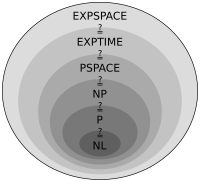Complexity class

Imagine you are playing a sorting game with your friends. Each of you has a bunch of pencils, and you need to arrange them in order from smallest to biggest. You start with a small number of pencils, but as you get better at the game, you keep adding more pencils to make it harder.
Now suppose there are some rules to this game. You can only move one pencil at a time, and you can't move a pencil past another pencil that's in the way. If you follow these rules, how long will it take you to sort all the pencils?
The amount of time it takes to sort the pencils is an example of a "complexity class." It's a way of measuring how hard a problem is to solve using a computer.
In computer science, we often talk about "computational complexity." This means how long it takes a computer to solve a particular problem. We measure computational complexity using "big-O notation." This gives us a way of comparing different algorithms and deciding which ones are more efficient.
There are many different complexity classes, but some of the most important ones are P, NP, and NP-complete. P stands for "polynomial time," which means that an algorithm can solve a problem in a reasonable amount of time, even as the size of the problem grows. NP stands for "nondeterministic polynomial time," which means that it's easy to check if a solution is correct, but hard to find the solution in the first place. NP-complete problems are the hardest problems in NP, and they are so difficult that no one has yet found an efficient algorithm to solve them.
So, going back to our sorting game, if you can come up with an algorithm that sorts the pencils in polynomial time, then it's a "P" problem. But if the number of pencils gets so large that it takes an unreasonable amount of time to sort them, then it might be an NP-complete problem.
In summary, complexity class is a way of measuring how hard a problem is to solve using a computer, and we use big-O notation to compare different algorithms and decide which ones are more efficient. The most important complexity classes are P, NP, and NP-complete, which describe how quickly problems can be solved as they get bigger and more complex.
Now suppose there are some rules to this game. You can only move one pencil at a time, and you can't move a pencil past another pencil that's in the way. If you follow these rules, how long will it take you to sort all the pencils?
The amount of time it takes to sort the pencils is an example of a "complexity class." It's a way of measuring how hard a problem is to solve using a computer.
In computer science, we often talk about "computational complexity." This means how long it takes a computer to solve a particular problem. We measure computational complexity using "big-O notation." This gives us a way of comparing different algorithms and deciding which ones are more efficient.
There are many different complexity classes, but some of the most important ones are P, NP, and NP-complete. P stands for "polynomial time," which means that an algorithm can solve a problem in a reasonable amount of time, even as the size of the problem grows. NP stands for "nondeterministic polynomial time," which means that it's easy to check if a solution is correct, but hard to find the solution in the first place. NP-complete problems are the hardest problems in NP, and they are so difficult that no one has yet found an efficient algorithm to solve them.
So, going back to our sorting game, if you can come up with an algorithm that sorts the pencils in polynomial time, then it's a "P" problem. But if the number of pencils gets so large that it takes an unreasonable amount of time to sort them, then it might be an NP-complete problem.
In summary, complexity class is a way of measuring how hard a problem is to solve using a computer, and we use big-O notation to compare different algorithms and decide which ones are more efficient. The most important complexity classes are P, NP, and NP-complete, which describe how quickly problems can be solved as they get bigger and more complex.
